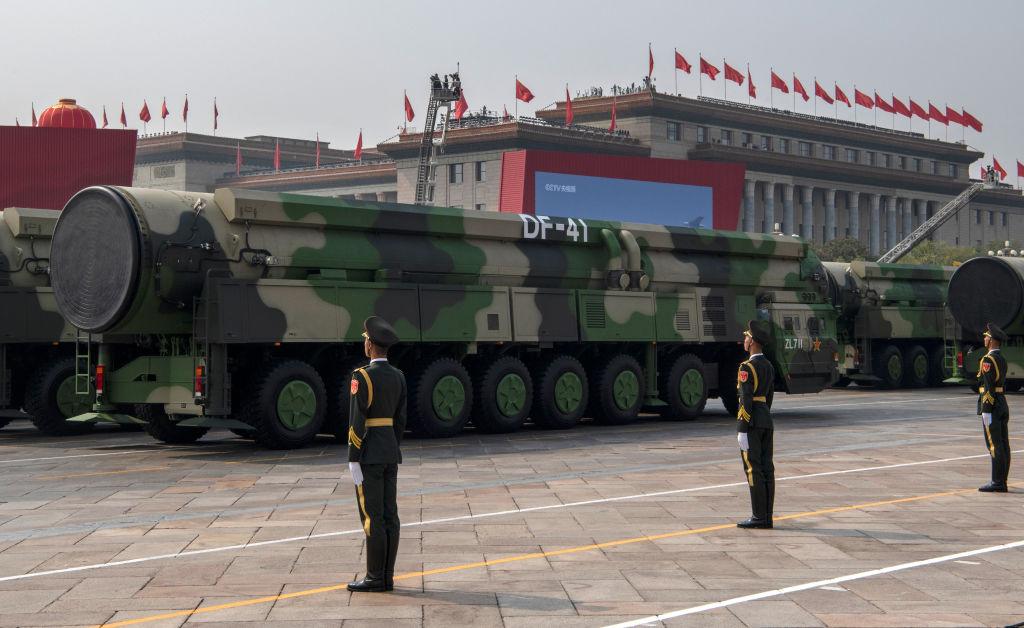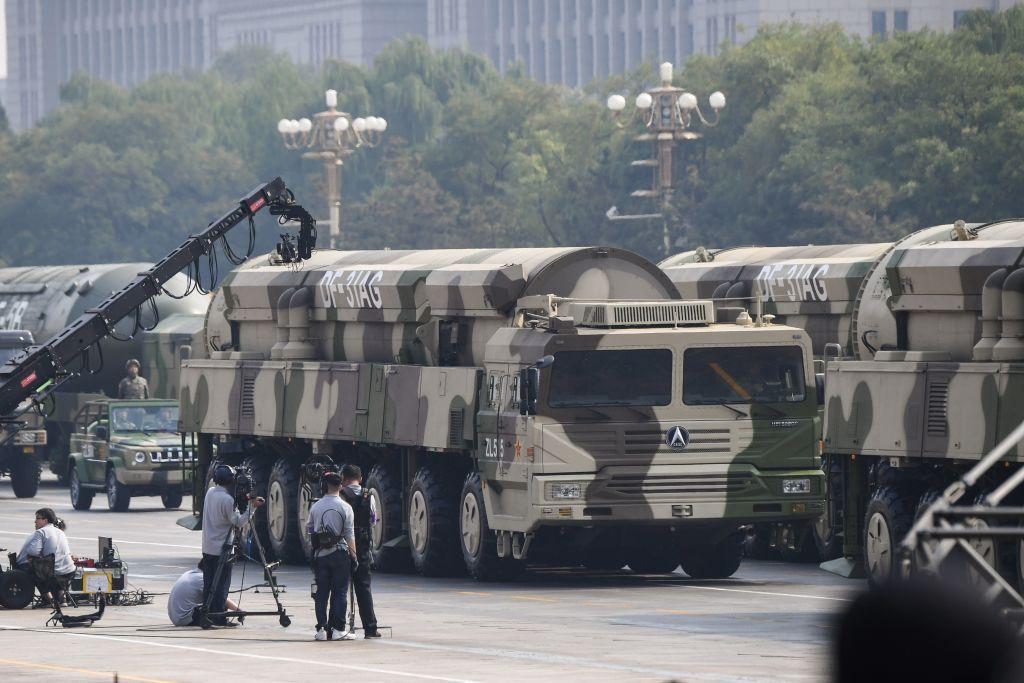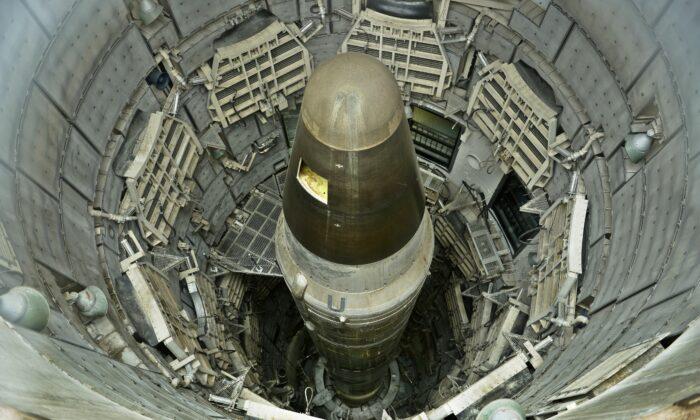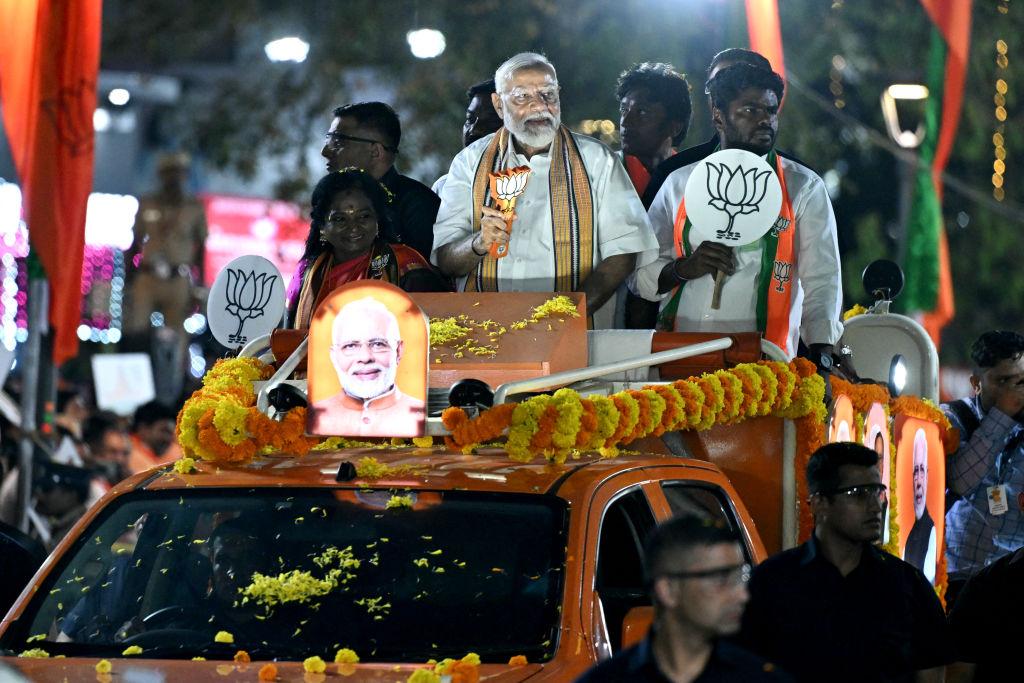NEW DELHI—China is building 120 new silos for intercontinental ballistic missiles (ICBM) near its northwestern desert city of Yumen, indicating a significant expansion in its nuclear arsenal and sparking concerns of a Taiwan-related conflict between China and the United States.
Communist China has always regarded Taiwan as a rebel province and has for some time pressured other nations to deny it diplomatic and trade relations, seeking to force Taiwan to choose unification with China. But recently there has been a drumbeat of hostile rhetoric emanating from Beijing suggesting war to take Taiwan is a possibility, and the new missile silos may be part of that initiative.
Construction of these silos began in March 2020, with major assembly escalating after February 2021. The silos are likely meant for China’s DF-41 ICBM, which is capable of carrying multiple warheads, according to a satellite imagery analysis by the James Martin Center for Nonproliferation Studies at the Middlebury Institute of International Studies at Monterey (CNS/MIIS).
Lewis said that he “leans strongly towards” the interpretation that China is possibly building a large number of silos to “complicate the ability of the United States” to target China’s ICBM stockpile.
S. Chandrashekhar, a former scientist with the Indian Space Research Organization, told The Epoch Times that the silos might be needed to increase the survivability of China’s ICBMs, and that the Chinese regime may want some of those missiles to have the protection of underground tunnels with silos for launching.
“They may also use rail or other [forms of transportation]—moving them around to increase survivability,” he said, noting that the United States and even the Soviet Union had used such approaches during the Cold War.
“All of these that are reported are a logical extension of a plan that China has been pushing for some time.”
The Epoch Times couldn’t independently verify whether the 144 new silos under construction in China cited by Lewis included the 16 identified by Kristensen.

Possibility of US–China Conflict
Kunal Singh, a doctoral candidate who studies nuclear weapons at the Massachusetts Institute of Technology, told The Epoch Times in an email that he views the increase in silos as an indication of Chinese leadership becoming more serious about the possibility of a U.S.–China conflict in the coming years.“Any such conflict can remain limited but can also escalate even if none of the parties want it to,” Singh wrote. “China does not have nuclear parity with the United States. Far from parity, China is believed to have just enough nuclear warheads so as to threaten some retaliation after the United States strikes first.”
Abhishek Darbey, a research associate with the New Delhi-based Center for China Analysis and Strategy, told The Epoch Times that the United States has around 5,500 nuclear weapons, while China has around 350.
“There is a huge gap,” Darbey said. “Also, in terms of the deployment, the United States has nearly 1,376 nuclear weapons at any one time, while the Chinese have 50 to 70 ICBMs.”
Singh said this parity indicates that China doesn’t have a large number of backup forces, and building silos is a way to make sure that the United States will have to squander many of its missiles on those silos if it ever decides to strike China first.
“These silos could absorb a large number of U.S. missiles and this, China hopes, will keep the mobile missiles safer,” he said. “Essentially, the move seems to be driven by a calculation that a U.S.–China conflict has become much more likely, and hence, Beijing cannot just rest easy with its wafer-thin second-strike survivability.”
According to the CIA, China’s present development of its road-mobile solid-fuel ICBM arsenal was triggered by the deployment of Trident II D5 missiles by the U.S. Navy in the Pacific, Kristensen said.
“This action-reaction dynamic is most likely a factor in China’s current modernization,” he said.
Chandrashekhar said that by building more silos, China is sending a clear message to the world. “The silos for the DF 31 and DF 41 may be ... [to] make it known to all that they have the numbers and the mobility to survive and retaliate,” he said, noting that those missiles are all aimed toward the United States.

“Other missiles located all over China on mobile transporters, submarines, aircraft, and ships—along with several other platforms and weapons—address regional actors such as Japan, Guam, and Taiwan.”
Pressure on the Region
According to Singh, if the Chinese regime’s silo buildup is in preparation for a possible conflict with the United States, it may force regional U.S. allies to reconsider their approach to China.“Indirectly, if the silos are an indication that a conflict over Taiwan is coming sooner than we expected, that raises a number of questions for Indo-Pacific countries like India, Japan, and Australia,” he said. “Each will have to decide the kind of role it has to play in the run-up to such a conflict and during the conflict.”
Darbey said U.S. military activities have increased around the eastern coast of China, the Taiwan Strait, and the South China Sea. Almost every day, there’s an American aircraft or a ship near the Chinese coast. He also noted that such activities are usually followed by some Chinese military response and other diplomatic reactions from the Chinese foreign ministry.
“These activities from either side are escalating both in terms of frequency and severity, and it has really created pressure for the Chinese Communist Party,” he said. “The silos are actually to create a deterrence against the U.S. for any possible intervention in the Taiwan Strait, Taiwan, or China.”
The Biden administration also sent an unofficial delegation to Taiwan in April this year, which the Chinese regime objected to, saying that it’s against the bilateral agreement signed between the two sides. Darbey noted that the United States also supports Taiwan militarily, which has always been looked upon unfavorably by the regime.
However, Chandrashekhar said that the likely possibility of any tense situation escalating into a hot war is very low.
“Small conflicts, tit-for-tat responses, especially in the South and East China seas, saber-rattling, a lot of media hype—all will happen,” he said. “Direct war? Unlikely.”





